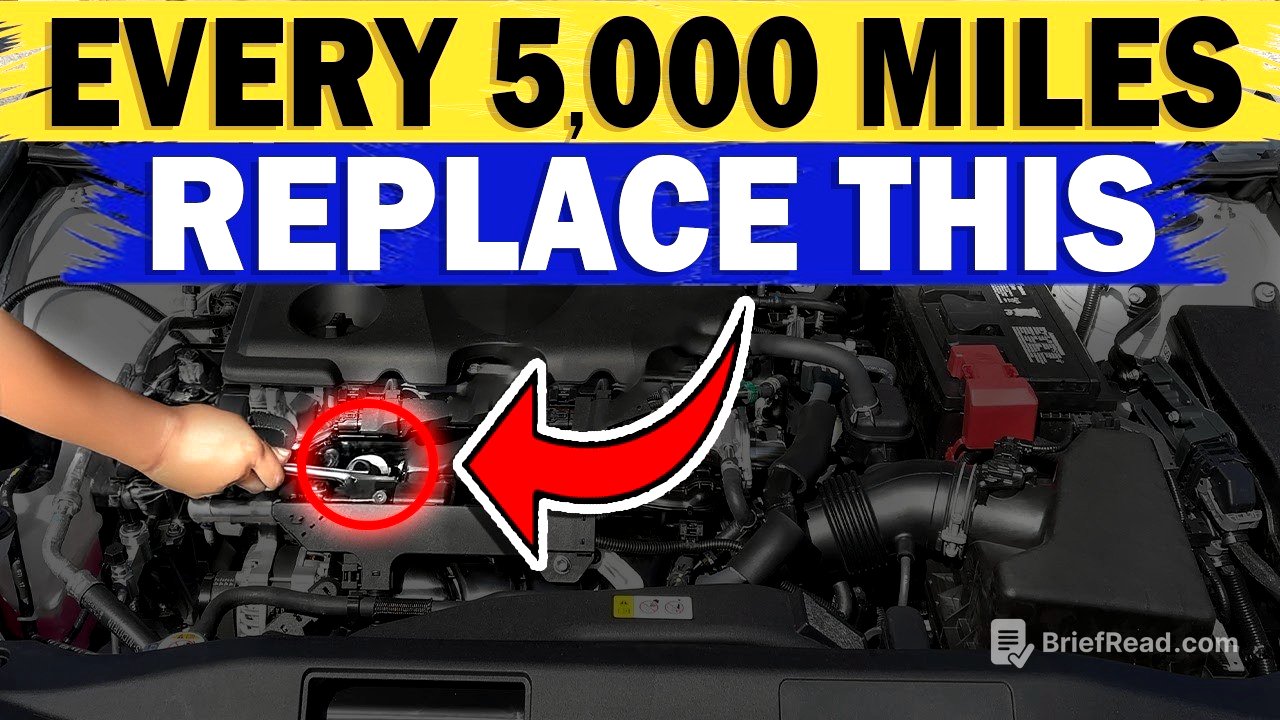TLDR;
This video outlines 13 essential maintenance habits to extend the life of a car to 300,000 miles or more, preventing costly repairs. It covers crucial aspects such as oil changes, transmission fluid maintenance, coolant flushes, timing belt replacements, spark plug maintenance, fuel filter replacements, brake fluid flushes, differential and transfer case service, MAF sensor cleaning, PCV valve replacement, tire alignment, avoiding cold revving, and undercarriage washes. The video emphasizes the importance of proactive maintenance and record-keeping to identify potential issues early and maintain vehicle value.
- Regular maintenance is key to preventing breakdowns and extending vehicle life.
- Following manufacturer recommendations blindly can lead to premature wear and costly repairs.
- Keeping a detailed log book helps track maintenance and identify potential issues.
Oil Change Intervals [0:32]
The video challenges the manufacturer's recommended oil change intervals, suggesting they are often too long and can lead to engine damage. While manufacturers may suggest 10,000-mile intervals to lower ownership costs, especially during the warranty period, mechanics and experienced drivers recommend changing oil every 5,000 miles or every 6 months using full synthetic oil. This is particularly important for those who drive in heavy traffic, tow, or live in hot or dusty environments. Sticking to shorter intervals helps prevent sludge buildup and premature engine failure, which can result in costly repairs.
Transmission Fluid Changes [1:57]
The importance of regular transmission fluid changes is highlighted, as many drivers neglect this until problems arise. Unlike engine oil, transmission fluid is often sealed and not regularly checked or changed, leading to a buildup of microscopic particles and varnish that can damage the transmission. A drain and fill every 60,000 miles or 6 years is recommended, or 90,000 miles for hybrids. It's crucial to avoid flushing old, neglected transmissions, as this can dislodge debris and cause further issues. Always use OEM fluid to ensure compatibility and optimal performance.
Coolant Flush [3:43]
The video stresses the necessity of flushing the coolant every 5 years or 50,000 miles, despite the misconception that coolant lasts forever. Over time, coolant becomes acidic and corrosive, leading to damage to water pumps, seals, heater cores, and head gaskets. Ignoring coolant maintenance can result in white smoke from the exhaust, misfires, and coolant loss. Regular coolant flushes are a simple and cost-effective way to prevent expensive engine repairs.
Timing Belt Replacement [5:09]
The importance of replacing the timing belt before it fails is emphasized. This hidden belt controls critical engine components, and failure can cause severe engine damage, costing between $2,000 and $5,000 to repair. Replacement is typically needed every 60,000 to 100,000 miles or every 7 to 10 years, whichever comes first. Since timing belts usually break without warning, proactive replacement is crucial to avoid catastrophic engine failure.
Spark Plug Maintenance [6:23]
The video discusses the importance of maintaining fresh spark plugs for optimal engine performance and fuel economy. Worn spark plugs can reduce fuel economy by up to 30% due to weak spark and poor fuel burn. Replacement is generally recommended every 60,000 to 100,000 miles, depending on the type of spark plug. Signs of failing spark plugs include rough idle, slow starts, weak acceleration, and misfires.
Fuel Filter Replacement [7:43]
The necessity of replacing the fuel filter at recommended intervals to prevent fuel pump failure is explained. A clogged fuel filter forces the fuel pump to work harder, potentially leading to its failure. Replacement is typically recommended every 30,000 to 60,000 miles for older cars and up to 100,000 miles for newer cars with in-tank filters. The video also provides a pro tip on relieving fuel pressure before changing the filter to prevent fuel spillage.
Brake Fluid Flush [8:50]
The importance of flushing brake fluid every 2 to 3 years is highlighted for maintaining safe braking performance. Brake fluid is hygroscopic and absorbs moisture, which lowers its boiling point and can lead to brake failure. A simple brake fluid tester can be used to check the moisture level, and if it exceeds 3%, a flush is recommended.
Differential and Transfer Case Service [10:25]
The video explains the need for regular differential and transfer case service, particularly for rear-wheel drive and all-wheel drive vehicles. The fluid inside these components breaks down over time, and experts recommend changing it every 30,000 to 50,000 miles. The video provides a step-by-step guide on how to perform this service, recommending supervision by a mechanic for the first few times.
Mass Air Flow (MAF) Sensor Cleaning [11:57]
The importance of checking and cleaning the mass air flow (MAF) sensor is discussed. A dirty MAF sensor can cause the engine to miscalculate the air-fuel mixture, leading to various performance issues. Cleaning the sensor with a MAF sensor cleaner can resolve these issues and save money on expensive replacements. The video provides a step-by-step guide on how to safely clean the MAF sensor.
PCV Valve Replacement [13:52]
The video covers the need to replace the PCV (Positive Crankcase Ventilation) valve to prevent harmful vapors from building up inside the engine. A clogged or stuck PCV valve can lead to oil leaks, high oil usage, and rough engine performance. Replacement is typically recommended every 30,000 to 50,000 miles. The video provides a simple guide on how to replace the PCV valve.
Tire Alignment [15:18]
The importance of tire alignment every 15,000 miles or when steering feels off is explained. Misalignment can cause uneven tire wear, reduce tire life by up to 30%, and decrease fuel mileage by up to 10%. Signs of misalignment include uneven tire wear, the car pulling to one side, and a crooked steering wheel.
Avoiding Cold Revving [16:46]
The video addresses the debate around cold revving, advising against it. Cold revving can cause metal components to grind together with little to no lubrication, leading to premature wear. Instead, it's recommended to let the car idle for 30 seconds to a minute to allow oil to circulate before driving gently.
Undercarriage Wash [18:25]
The importance of washing the undercarriage, especially in winter, is emphasized. Road salt, mud, and grime can cause rust and damage to critical components. Regular undercarriage washes, at least once every season or monthly in snowy areas, can prevent this damage.
Bonus Tip: Keeping a Log Book [19:27]
The video concludes with a bonus tip: keeping a log book to record all maintenance activities. This helps spot patterns, aids in diagnosing problems, and increases the car's value when selling.









